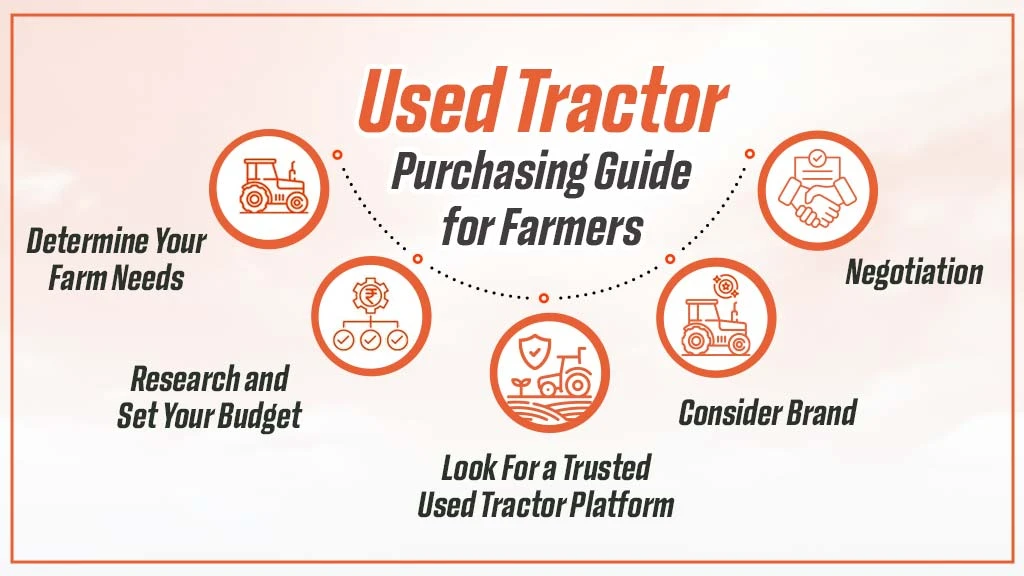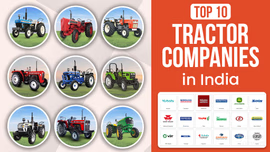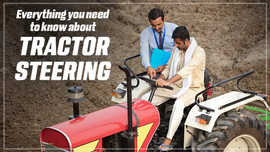Things to Consider Before Purchasing a Used Tractor in India

Table of Contents
Used Tractor Purchasing Guide for Farmers

Tractors are a versatile machine that are used for various agricultural operations. Therefore, let’s look at some of the factors to keep in mind for purchasing a used tractor:
Determine Your Farm Needs
First and foremost, you are supposed to thoroughly look into your farm needs and expectations from a tractor. Determine the size and type of the tractor on the basis of your land size, crops, and usage. For instance, if you are planning to utilize the tractor mainly for ploughing & puddling like operations then a 4WD tractor may be a better option than 2WD. They also offer better resale value. Mini tractors are compact and suitable for orchard or vineyard farming. If you are looking for a tractor that is suitable for both commercial tasks and heavy-duty farming then tractors higher than 50 HP are an appropriate option.
Research and Set Your Budget
Once you come to a decision regarding which type of used tractor you require, then, begin with researching the tractors in that category with their market price range. Also, consider the cost of maintenance for the tractor model you are thinking of purchasing to ensure it fits into your budget. To get your hands on your desired used tractor model, you can explore your nearby dealership or specific second-hand tractor agencies. Based on the research, opt for the best tractor model which serves your requirements and also falls under your set budget.
Look For a Trusted Used Tractor Platform
It is very important to purchase the tractor through a trusted platform which provides you technical guidance and assistance regarding the tractor you want to buy. For instance, Tractorkarvan is one such platform which has listed 1500+ used tractors from top brands in good condition that are verified by tractor experts. You can directly connect with the seller and make an offer for the tractor you finalize. You can also take help of our used tractor loan facility to buy your finalized tractor.
Consider Brand
Consider purchasing a tractor from a reputable brand which is known for its durability and reliability. It will also offer a better resale value. Established brands often have a wider network of service centers and easier access to spare parts which will later on impact your maintenance and repairs experience.
Negotiation
The best thing about used tractors is that their prices are affordable and negotiable. Their price can vary based on the particular model, year, condition and location. However, be ready to negotiate the price with the seller. Make sure to discuss any potential issues or concerns with the seller. If you come across any problems, negotiate a fair price based on repair or maintenance costs. Additionally, there are high chances of getting implement combo deals with the used tractor. Depending on your negotiation skills, you can get the required tractor along with compatible implements at best rates.
How to Inspect a Used Tractor?

Inspecting a used tractor is critical and at the same time challenging for a farmer thinking to buy it. Now that you are aware about the primary things which you should prepare yourself for before purchasing a used tractor, let's look into some further details to inspect the tractor:
Check Total Hours of Operation
Firstly, just check the number of hours of operation the tractor has performed. Diesel engines are considered good in between 6000 to 10,000 hours of operation. However, it all depends on the tractor model and maintenance of the tractor. Some tractors perform well even beyond this range.
Check Engine and Transmission
Began inspecting the engine by checking the oil level. Too low oil level and a dark brown color is a sign of neglect. This neglect can cause a buildup of sludge in the engine. Look for any excessive smoke and unusual noises while the engine is running as they can be a sign of internal problems in the engine. Also, inspect the engine, transmission, and hydraulic systems for signs of oil, coolant, or fuel leaks. These leaks not only indicate potential problems but can also lead to frequent maintenance. When it comes to transmission, make sure that there are no unusual sounds while gear changing and the gear shifting is quite smooth. Furthermore, look for any cracks or damage to the transmission housing.
Check Tyres, Clutch, and Brakes Condition
Check if there are any signs of uneven wear, cracking, inflation, or punctures in tyres. Repeatedly engage and disengage the clutch to check if it is operating smoothly. A slipping or deteriorated clutch can cause issues like inefficient power transfer or challenging gear shifts. Pay attention to the clutch and brake pedal's responsiveness and ensure it feels firm. An important tip for you – Tyres, Clutch and brakes are critical components however they are replaceable. Hence, do not reject the tractor you have liked just for these reasons, question the cost vs benefit and go for it!
Take Tractor Demo
Move ahead by taking a tractor demo once you have done all the necessary checks. Test its PTO and hydraulics. Ensure that the PTO shaft is rotating smoothly at the correct speed and there are no unusual sounds coming from the output shaft. Test the hydraulic system by engaging and disengaging attachments observing how they respond. Make sure there are no chattering sounds coming from the pump while lifting as this indicates insufficient flow of hydraulic fluid to the pump.
Check Documentation and Service History
Lastly, one of the most important things is to ensure all the necessary documents of the tractor are available and valid. This includes Registration Certificate (RC), Insurance documents, owner’s manual. Also, to go deeper into the tractor health, review the service history of the tractor. Visit a nearby authorized service center and seek the service card which will give you the details of no. of services done, parts replaced, etc. This will provide you a clear picture about its maintenance history and requirements which may be missed by the seller.
Conclusively, purchasing a used tractor in India can be a cost-effective solution for farmers if done appropriately. Remember that a well-maintained used tractor can offer the reliability and performance you need at a fraction of the cost of a new one. By applying the above-mentioned steps and tips to your buying process, you can ensure that you are investing in a tractor that delivers consistent performance and is value for money.


Related Blogs












